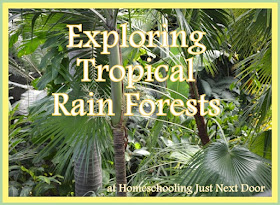Each week, for the first eleven weeks of the school year, the Kindergarten through third grade science co-op class I teach is studying a biome or ecosystem. After learning about temperate forests, naturally, we studied tropical rain forests. Exploring both ecosystems in back to back classes helped students learn the similarities and differences of the two types of forests.
The class began with an introductory lecture using highlights from lesson 11 of Properties of Ecosystems, by Debbie and Richard Lawrence.
These highlights included:
- grow in tropical zone (near equator)
- more than 80" rain per year
- more than 1/2 of land animals and birds of the world call it home
- specific species of mammals, birds, and reptiles
- plants and produce, including medicines and food like pineapples, peppers, and cocoa
Next the students completed a worksheet entitled "It Came from the Rainforest" from Habitats: Science Works for Kids Series, Evan-Moor, page 33. This was a simple matching exercise, but it helped stimulate discussion about rain forest products the children encounter daily.
Next, we covered layers of the forests using material from lesson 9 of Properties of Ecosystems, by Debbie and Richard Lawrence. The vocabulary words the children learned were:
- emergent layer
- canopy
- understory
- forest floor
Using the three page line drawing of a tropical rain forest from Animal Habitats: Grades 2-3, by Donald M. Siliver and Patricia J. Wynne, pages 71-75, students tried to locate and color some of the animals mentioned as I read Amazon Alphabet, by Martin and Tanis Jordan. Not all the animals from the book matched the activity pages, but enough did. This was a favorite activity for the children.
Afterwards, they created a Blue Morpho Butterfly using the steps outlined in Animal Habitats! by Judy Press.
Those who finished early worked at piecing together a floor puzzle called Rain Forest, by Melissa and Doug.
Finally, I read If I Ran the Rain Forest, by Bonnie Worth. This fun Dr. Seuss Learning Library book entertains and informs. It served well to summarize all the children had learned during the lesson.
Resources:
Properties of Ecosystems, by Debbie and Richard Lawrence
Tropical Rain Forests, by Peter Benoit
Tropical Rainforests, by Seymour Simon
Amazon Alphabet, by Martin and Tanis Jordan
If I Ran the Rain Forest, by Bonnie Worth
Tropical Forests: Animal Classifying Cards
Other Resources a.k.a. Extra Stuff My Child Got to Do Because I Am the Teacher:
The Umbrella, by Jan Brett
In a similar fashion to The Mitten, Brett weaves a tale of an unlikely boat, an upside down umbrella, floating down a stream in a tropical rain forest. Many animals, such as a toucan, jaguar, tree frog, and tapir, inadvertently take a ride together in the umbrella boat. All is well, cramped, but well, as the animals jostle down the river, until one little hummingbird wants a ride, too. If you are familiar with The Mitten, then you can probably guess how this one ends.
Verdi, by Janell Cannon
We loved Stellaluna, and we loved Verdi too! A baby emerald tree boa starts out determined not to change. He loves his adventurous spirit and his yellow color. He tries his best not to grow old and green. It is an adorable story to share with a youngster.
Oh, No! by Candace Fleming & Eric Rohmann was a fun read aloud my son loved. A deep hole in the ground holds a mouse, monkey, frog, and other animals who accidentally fall into it. Just as they are attempting to escape along comes a tiger.




No comments:
Post a Comment